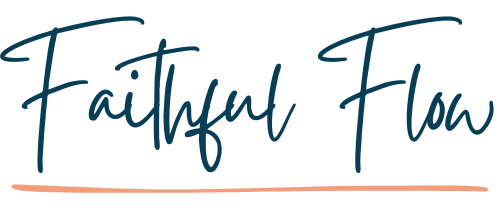If you follow yoga trends on social media, you might think Somatic Yoga is a new creation or style of yoga. Somatics, sometimes called release work, is nothing new. Dancers and athletes have used it for years to prevent injury and counter the effects of repetitive movements. In somatic yoga, we focus on light movements that bring on a sense of calm, balance, and release and increase the mind-body connection.
The word Somatics is derived from the Greek root term Sόma. Greek writings by Homer and Hesiod use this word for living bodies. This root word shows up 142 times in the New Testament. Here, it can have a literal meaning referring to a living body (Matthew 10:28), a corpse (Matthew 27:59), or celestial bodies (1 Corinthians 15:40). Figuratively, it’s used to describe the church as the body of Christ (Romans 12).
In somatic yoga, we consider our body something to observe and understand. There are many approaches to do this within the somatics family. The goal is to cultivate a deep understanding of our body and movement, sense tension or abnormalities, and build inner awareness.
We can learn about and rewire some of our habitual patterns through somatic movement. Think of somatic yoga as a bit like self-study. It can help to support health by moving us away from survival mode and unconscious patterns that arise from stress or trauma.
Somatic Movement vs Asana
Unlike conventional yoga, which often focuses on external alignment and poses, somatic yoga encourages you to turn inward and explore your body and sensations. A teacher may ask you to move in a certain way, but there are no standard poses that you are trying to achieve.
In a world filled with hustle and bustle and yoga classes that often focus on goals or poses, somatic yoga provides an opportunity to slow down, tune in, and listen to the whispers of your body. Like traditional yoga, this practice combines movement, breathwork, and mindfulness.
In a world filled with hustle and bustle and yoga classes that often focus on goals or poses, somatic yoga provides an opportunity to slow down, tune in, and listen to the whispers of your body.
Examples of Somatic Yoga
Any movement that calms your mind and helps you to tune into your body can fall under the somatic movement umbrella. But here are a few options to help you explore:
Mindful Movement Exploration:
Begin your somatic yoga journey with a gentle movement exploration. Stand tall, close your eyes, and start swaying gently from side to side. Feel the subtle weight shifts, notice how your muscles engage, and release any tension. This simple movement encourages a mindful connection with your body, paving the way for a deeper understanding of its nuances.
Breath Awareness Meditation:
Find a comfortable position, close your eyes, and bring your attention to your breath. Inhale slowly, feeling the expansion in your chest and abdomen, and exhale with equal mindfulness. The key here is not just the act of breathing but being fully present in each breath. This practice enhances your awareness of the subtle impact of breath on your body and mind.
Body Scan in Savasana:
Savasana, or corpse pose, takes on a new dimension in somatic yoga. Lie down comfortably, close your eyes, and bring your awareness to different parts of your body, starting from the crown of your head and work your way down to your toes. Notice any areas of tension, and with each exhale, release and soften those spaces. This body scan fosters a profound sense of relaxation and self-awareness.
Fluid Movement Sequences:
Traditional yoga often involves static poses, but somatic yoga introduces fluid movements. Imagine a slow, thoughtful flow where you seamlessly transition from one posture to another. This dance-like practice enhances flexibility and allows you to explore the full range of motion, promoting a sense of freedom and ease.
Clench and Release:
While lying down, clench your hands, flex your feet, tighten your legs or arms, and release the muscles with a deep exhale. The dichotomy between tense and relaxed muscles helps us identify when we are unconsciously tense and allows us to use our breath to relax.
Embodied Yoga Nidra:
Yoga Nidra, or yogic sleep, is similar to savasana but is a guided practice. Lying down comfortably, you’ll be led through a meditation that brings attention to different body parts, creating a profound sense of relaxation, awareness, presence, and rest.
Explore with Touch:
Touch your body. If you’re enjoying some fluid spinal movements in an easy seat, add some touch by rubbing your hands up and down your thighs. If you’re lying on your back in constructive rest, hug yourself.
One of the themes of the gospels is that Jesus touches the untouchable. He healed a man with leprosy, several blind men, and a woman who bled for 12 years. Touch was central to all these healings. Touching can remove barriers, cleanse, heal, and restore. It increases oxytocin, our feel-good hormone, and promotes physical, mental, and emotional health. We often deprive ourselves of this simple but profound healing technique, and somatic yoga is an excellent opportunity to add some touch to your life.
Benefits of Somatic Yoga
Now that we’ve dipped our toes into somatic yoga let’s explore the benefits this practice can bring:
Heightened Body Awareness:
Somatic yoga is a gateway to understanding your body on a deeper level. You become more aware of your body’s signals by tuning into the sensations and movements, which promotes a mindful and intuitive connection. You may even notice nodules or abnormalities that require medical attention that would otherwise go unnoticed.
Stress Reduction and Relaxation:
The fluid movements, breath awareness, and mindful exploration promote relaxation and significantly reduce stress.
Enhanced Mind-Body Connection:
Somatic yoga isn’t just about physical movements; it’s a holistic practice that nurtures the mind-body connection. It increases our ability to pay attention to even the most subtle changes and messages from our body and mind.
Release of Chronic Tension:
Many of us carry tension in specific areas of our bodies without even realizing it, such as our neck and shoulders or lower back. Somatic yoga provides a platform to identify and release chronic tension, promoting a sense of ease and comfort.
Neuroplasticity:
Somatic yoga’s movement and mind-body connection leverage our brain and nervous system’s ability to rewire itself. We learn our body’s current movement patterns and habits and promote new and healthier ones through this practice.
Improved Flexibility and Mobility:
Somatic yoga’s focus on fluid movement enhances flexibility and mobility. Moving through a full range of motion encourages the joints to remain supple and agile.
This article discusses the differences between flexibility, mobility, and range of motion.
Somatic yoga is all about letting your mind and body be your guide. There are no perfect poses or movements to achieve; instead, it’s about savoring the process, one mindful movement at a time. So, whether you’re a seasoned yogi or a curious beginner, try somatic yoga. Roll out your mat, close your eyes, take a deep breath, and explore all this simple practice offers.





0 Comments